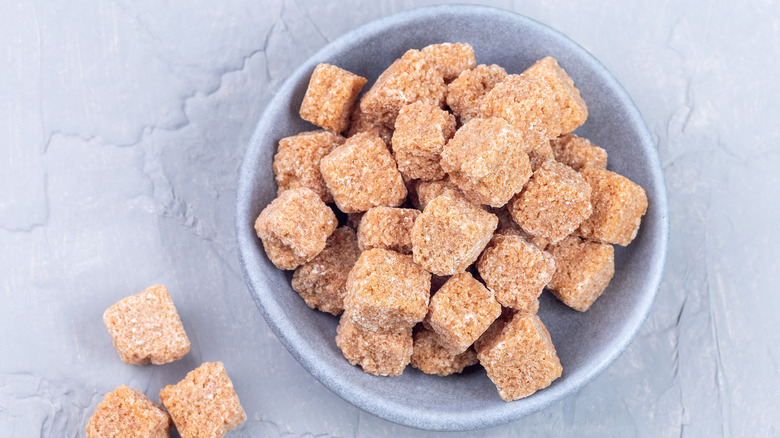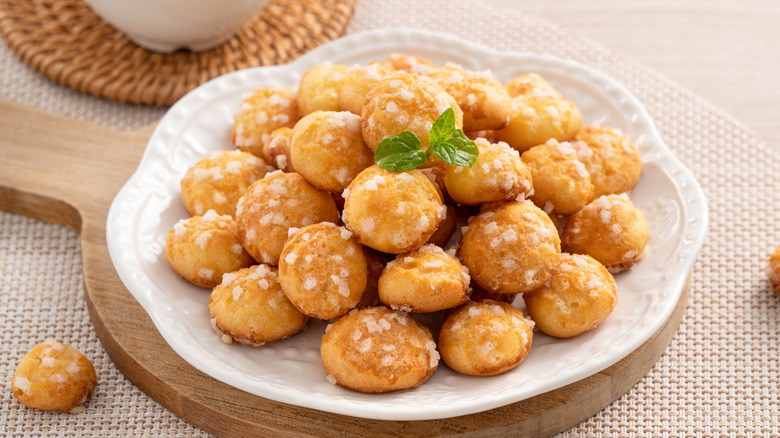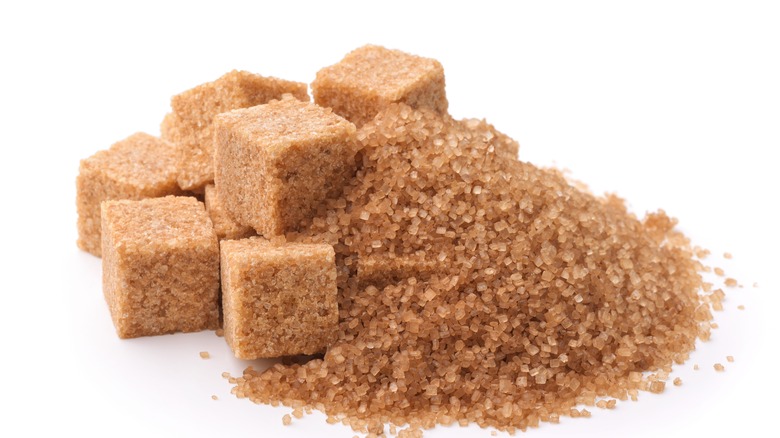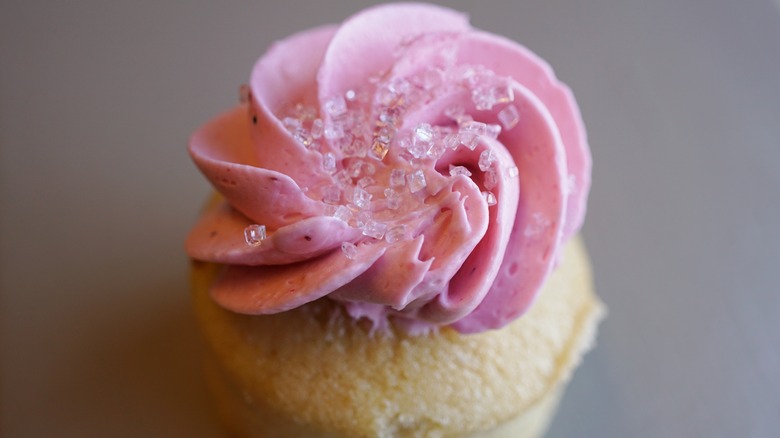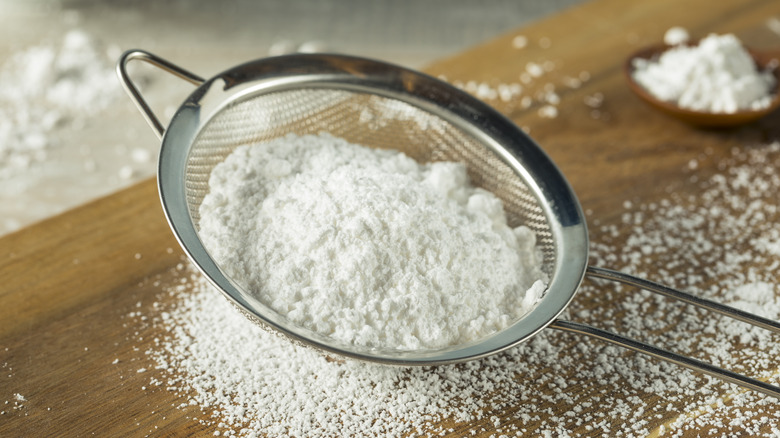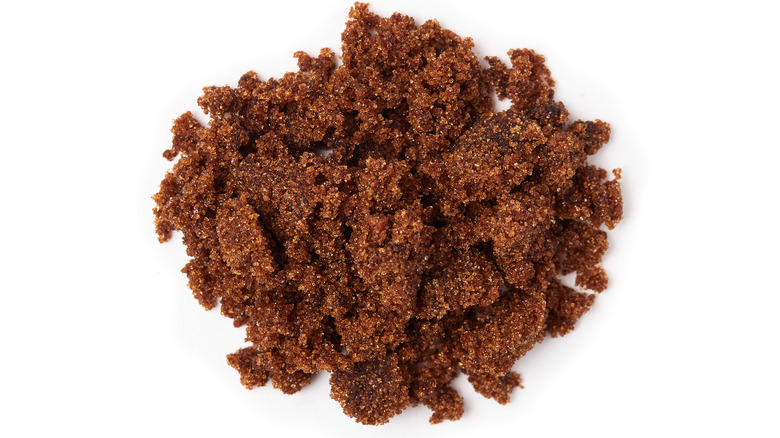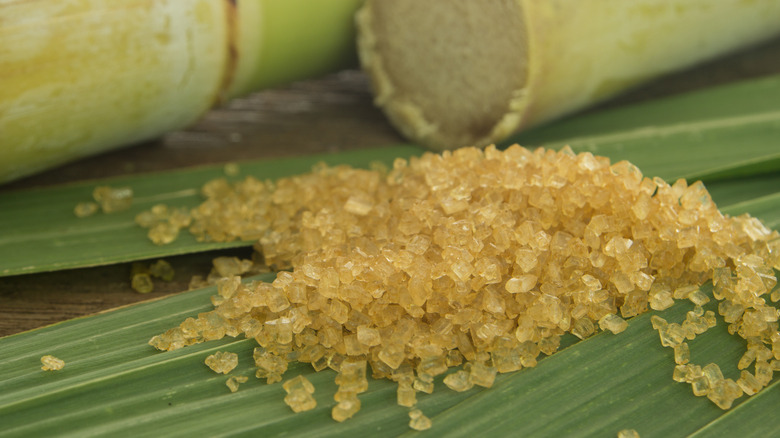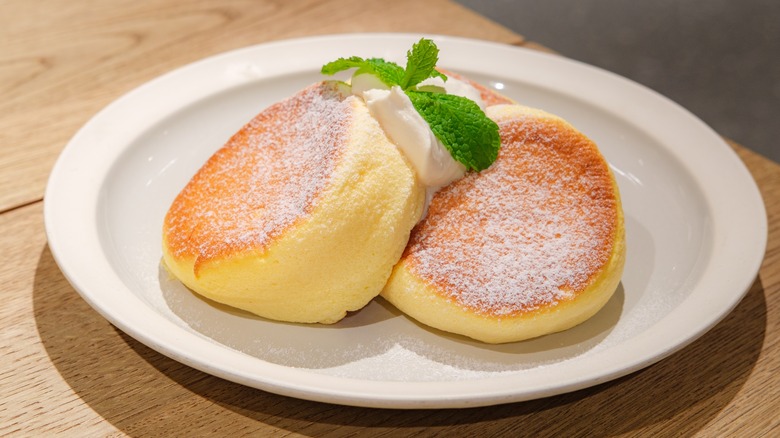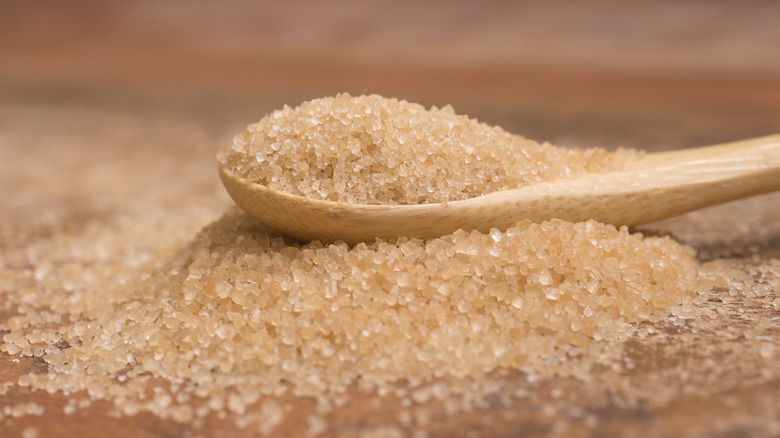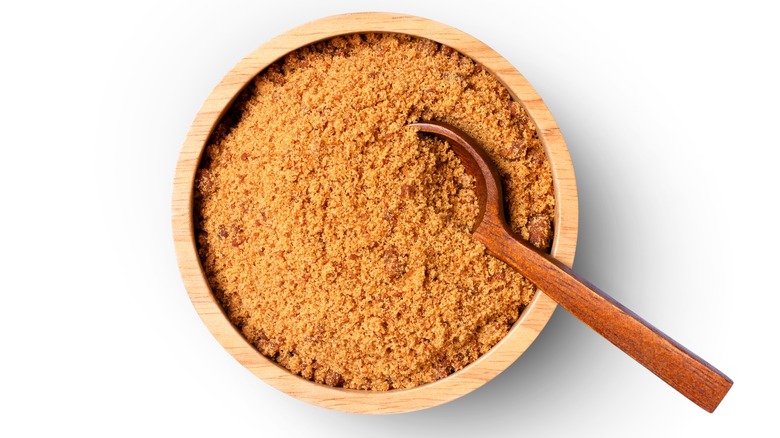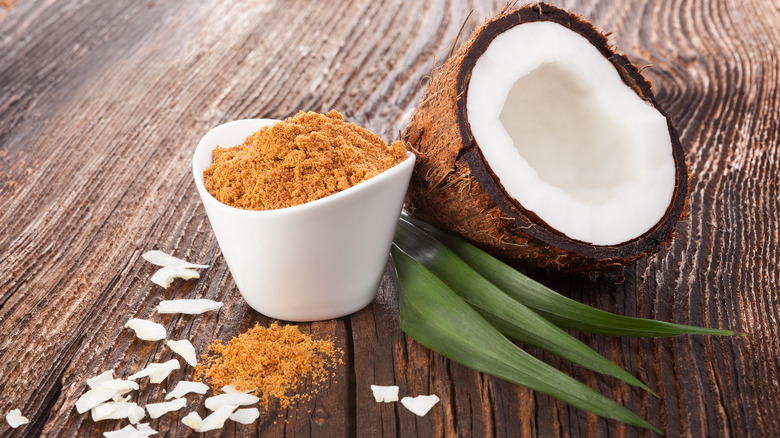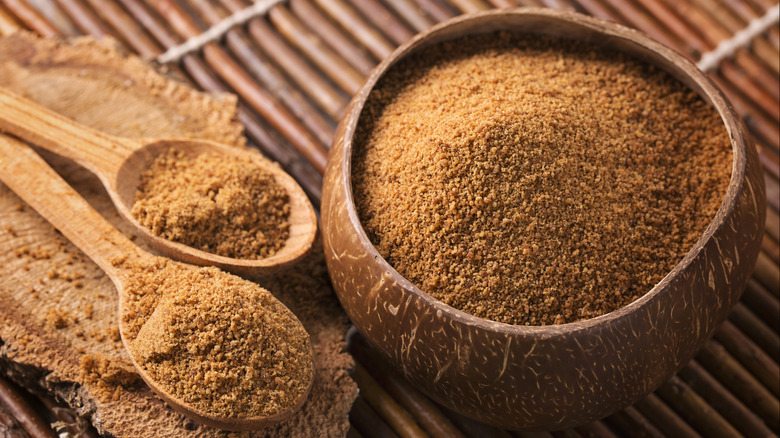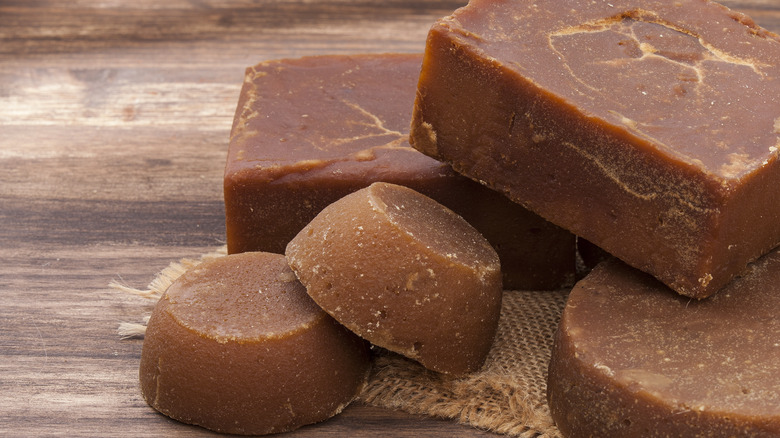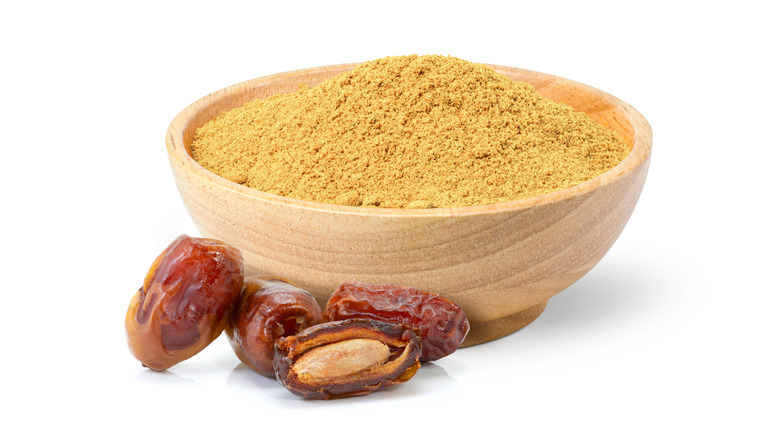13 Underrated Types Of Sugar You Should Use More Often
We may receive a commission on purchases made from links.
Good old sugar. As the Mary Poppins' song goes, a spoonful of it makes the medicine go down. Whether it's caster sugar for the perfect shortbread or a hefty dose of brown sugar in a creamy hot cocoa cake, it's the ingredient that seemingly knows no bounds. And it's not just about suffusing your dessert concoctions with a sugar rush (though, let's be honest, who can resist the good stuff?). Sweetness aside, sugar has myriad uses in baking. "Using sugar in baking isn't all about sweetness," nutritionist Kerry Torrens told the BBC. "It also gives us that delicious texture and crumb, the lovely golden-brown color, and it prolongs how long we can store our bakes... Sugar also keeps baked goods moist."
But when you're adding a cube of white or brown to your morning coffee, remember that there's so much more to the world of sugar than the usual suspects. The diversity of sugar is incredibly vast, with so many varieties on offer, all with differing tastes, textures, and aromas. And if you don't have a sweet tooth, fear not! The sugars in this rundown are suitable for pretty much anyone's palate. From marinated tofu and chicken dishes to the most delectable cakes and cookies, there's a range of uses just waiting for your taste buds. Pour a little sugar on it: here's the sweet lowdown on 13 underrated types of sugar you should use more often.
1. Pearl sugar
If you've ever stepped into a Swedish bakery, you've likely seen cinnamon buns and rolls sprinkled with distinct thick sugar granules. This unique coating is known as pearl sugar and is ideal for baking cozy winter treats. Pearl sugar is derived from compressed sugar crystals, hence its thick texture, as Cook's Illustrated notes. This ingenious ingredient is designed to sit atop your baked treats, rather than dissolve into the mixture.
Pearl sugar isn't just found in Swedish bakeries, however. In addition to its prevalence in Scandinavian countries, it's commonly used in Belgium and France. The next time you make Belgian waffles, you can up your game by using pearl sugar rather than regular white sugar. Previously chatting to The Daily Meal, Wafels & Dinges founder Thomas Degeest dished on the secret to perfect Belgian waffles. Yep, you guessed it: pearl sugar. "It has a very high melting point, so it doesn't burn when we cook our waffles at high temperatures," he explained.
In addition to using this one when baking desserts and pastries, it's the perfect sugar for breads. The thick coating goes amazingly well with brioche loaves, braided Swedish bread (known as Kanellängd), and banana bread. As The New York Times points out, pearl sugar is ideally accompanied by strong aromas such as cinnamon and cardamom, so be sure to take advantage of these the next time you want to ace your sugar-sprinkled comfort food.
2. Cane sugar
Cane sugar is, as the name suggests, derived from sugarcane, a grass found in tropical and subtropical climates. According to WebMD, Southeast Asian cultures have long used sugarcane in its unprocessed form as a natural remedy for various health ailments, due to its apparent antioxidant properties. But you can also utilize its refined, sugar form — cane sugar — to boost your bakes.
The main difference between cane sugar and white sugar is the color: refined cane sugar is darker than the white variety, possessing a golden brown hue. It's not to be confused with raw cane sugar (also known as turbinado — but more on that later), however, which is a much darker brown and has a more caramelized taste, per Helps Master.
Although it functions pretty much the same as white sugar, bestowing the same taste in baking, the darker color of refined cane sugar can change the overall look of your finished products. This is particularly helpful for foods that require a slightly darker shade for presentation purposes, such as banana bread, fruit loaves, or ginger snaps, in turn making your treats look more decadent and thus more delectable.
3. Sanding sugar
While most sugars are incorporated into baking mixtures, sanding sugar is used for decorative purposes. This unique sugar is known for its sparkly, almost otherworldly appearance. It comes in a vast array of vibrant pastel colors, from blues and pinks to lilacs and yellows, resembling something of a candyfloss rainbow, thereby making it ideal for beautifying your bakes.
As Haniela's notes, sanding sugar comes in two varieties: small grain, which is fine and airy, and large grain, which is coarser and, as the name suggests, has significantly larger crystals, giving it an almost glittery appearance. Additionally, rather than dissolving, sanding sugar tends to stick to surfaces when it comes into contact with water.
So, the next time you have to bake a batch of eye-catching sugar cookies, consider incorporating this oft-overlooked ingredient. Due to its sparkly appearance, sanding sugar is superb for adorning seasonal bakes. Accordingly, it makes for an innovative accompaniment to traditional royal icing, in turn upping your decorating game. Need to make your Christmas tree cookies glisten? Coat them with sanding sugar for the perfect, festive sparkle. Making bunny treats for Easter? Sanding sugar can truly enhance the aesthetics of the bunny's fur (bear in mind that your concoction may look too adorable to sink your teeth into). Aside from cookies, you can also use it to make your cupcake frosting pop — and crunch.
4. Confectioners' sugar
Unlike plain powdered sugar, confectioners' sugar is distinct due to the inclusion of starch, per Martha Stewart. The starch gives confectioners' sugar that famously thick consistency, making it one of the lightest yet most adaptable additions to your baking pantry. While this concoction is best known for its uses in royal icing and frosting, there are many other overlooked ways to use it.
The starchy nature of confectioners' sugar makes it the ultimate ingredient to incorporate into fudge recipes. While granulated or caster sugar can lead to a lumpy mix, confectioners' sugar gives fudge its smooth and refined texture. Additionally, the light and fluffy powder is ideal for making whipped cream. Simply mix 1 ½ cups heavy cream with ½ cup confectioners' sugar, and a pinch of vanilla extract for the perfect whipped topping.
There's nothing quite like sinking your teeth into the delicate texture of confectioners' sugar. Subsequently, you can use it as a dusting topper for various sweet treats, including cookies, scones, and donuts. Another firm favorite among sweet-toothed foodies is Turkish delight. A Middle Eastern delicacy, Turkish delight is traditionally made from lemon or rosewater and dusted with confectioners' sugar for a mouth-wateringly airy finish, per Hotel Chocolat. You can also sprinkle it upon cakes, particularly chocolate or lemon varieties, with the sugar both beautifying the treats and enhancing their taste.
5. Muscovado sugar
One of the most aesthetically pleasing sugars, muscovado resembles a fine dusty chocolate and, unsurprisingly, it's a great accompaniment for chocolatey recipes. According to Healthline, muscovado, which naturally contains molasses, is one of the least refined sugars. Despite resembling brown sugar, make no mistake: muscovado is in a whole different league. It's also far more natural than brown sugar (sorry to disappoint brown sugar foodies, but it's usually nothing more than white crystals with added molasses, per The Guardian).
Due to its naturally rich flavor and aroma, you should consider using muscovado the next time you make a chocolate cake or bake a batch of brownies. Its toffee tang will enhance the flavor of your bakes, making for a truly indulgent addition. Rich molasses also makes this the ideal sugar for baking ginger cookies. A combination of muscovado, cinnamon, and ground ginger create a melt-in-the-mouth, aromatic treat. What's more, muscovado need not be relegated to sweet bakes. Add a teaspoon of the stuff to marinated chicken for a unique tang, tantalizing your taste buds with a sweetness that perfectly counters heavy spices.
What's more, you can add muscovado to coffee for a sweeter morning brew. Bear in mind, however, that the aroma may be somewhat overwhelming, so sprinkle this ingredient in moderation. Ideally, it should be used with non-dairy milk, such as coconut, to balance out the heaviness of the sugar.
6. Turbinado sugar
Turbinado sugar is a form of cane sugar renowned for its rustic and raw appearance. As cookbook author Shauna Sever explained on "The Leonard Lopate Show," (6:35), the sugar gets its name from the way it is spun in a turbine during the refinement process. The thick and coarse granules resemble the salt found on pretzels, rather than sugar. But make no mistake: turbinado sugar can make all the difference to your kitchen concoctions.
As SFGate highlights, the rich color of turbinado sugar can be used to darken light baking mixtures. If you're sick of dry, bland bakes, consider adding this unique sugar to bread for an extra moist recipe. Turbinado also enhances the flavor of pancakes, so it works as a great substitute for traditional white sugar. Namely, the granules have a smooth caramel tang, which makes this one a particularly satisfying accompaniment to chocolate chip pancakes.
In addition to incorporating turbinado sugar into baking mixtures, it can be used as an enhancement in a number of foods, per Healthline. Sprinkle it as a crunchy topping over muffins and bread or add a dash to your oatmeal or toast for a hearty — and heartwarming — breakfast. And here's a boss apple crisp hack: Sprinkle a generous amount of turbinado sugar over your crumbly topping for that perfect crunch (this is ideal for toppings that have turned out a tad too buttery). What's more, it can be used in savory dishes, such as a spice rub for meat, or dusted over baked sweet potatoes to maximize flavor.
7. Johakuto
Unlike the desserts we're accustomed to in the States, Japanese sweet treats are known for being light and airy. So how do Japanese desserts get that exquisitely lightweight texture? Many of these delicacies are made with johakuto, also known as Japanese sugar. Unlike standard white sugar, johakuto is far lighter, with super fine crystals resembling powdery flour rather than typical sugar granules, per Oishii.
As Oishi So Japan points out, johakuto is extremely versatile and can be incorporated into a wide variety of dishes. The naturally moist properties of the sugar helps to keep baked goods soft, smooth, and springy. As an alternative to American pancakes, try making dorayaki, a Japanese delicacy that's renowned for its beautifully spongy texture. Like traditional pancakes, dorayaki is made with eggs, sugar, and flour, but johakuto is used in lieu of white sugar, making the finished product considerably more delicate, soft, and most notably, wonderfully moist. You can also use the sugar to dust traditional Japanese souffle pancakes.
In Japan, johakuto is also often used as an essential ingredient in savory dishes, such as certain types of sushi, soups, and tofu-based cooking. So, incorporate it into your next tofu dish to bring your vegetarian meals to the next level. Johakuto can be found at your local Japanese grocery store; otherwise, you can buy it online.
8. Demerara sugar
Like muscovado, demerara sugar is known for its rich molasses flavor, but it is significantly lighter in color and slightly coarser in texture, per The New York Times. Known for its crystal texture, it has a golden hue resembling sand and hails from the island of Mauritius. Demerara sugar is ideal for slightly bitter recipes such as crème brûlée. Instead of using plain brown sugar, opt for demerara when making the European staple's hard, crystalized topping. This will give your recipe a distinct toffee flavor that's pleasing to your taste buds and your nostrils.
Demerara is also one of the best sugars that you can use to up your gingerbread game. The subtly caramelized flavor is the perfect partner for ground ginger. So, the next time you make gingerbread, add a cup of demerara sugar to the recipe and marvel at that unique yet oh-so-familiar and comforting taste. Just be aware that the crystals are a lot rougher than brown sugar, so be sure to mix your batter thoroughly.
Also, you can make demerara syrup by mixing one cup water and one cup sugar. This makes for a superior alternative to standard syrup, with the demerara bestowing a richer and more flavorful experience. Either drizzle it over cakes or, for those who drink alcohol, add it to cocktails.
9. Unrefined brown sugar
We've all heard of refined brown sugar, but what about unrefined brown sugar? According to What Sugar, this one is the least processed of all sugars and is noted for its coarse and lumpy characteristics. Appearing somewhat rustic, it should come as little surprise that the unrefined brown sugar on offer in grocery stores is often certified organic. Despite not going through the same heavy processing as its refined counterparts, this sugar is still as sweet as the white kind, but with a richer and bolder flavor. It is, however, almost always more expensive than other varieties because it's typically imported from South American countries.
When it comes to baking with unrefined brown sugar, the deep flavors and caramel aromas are incomparable. As such, it's the ideal sugar for rustic bakes such as nutty loaves or biscotti. Indeed, this one is near unmatched as a flavor enhancer, as Gourmet Traveller highlights. However, you also need to keep in mind that baking with this overlooked sugar can be a tad tricky. Due to the rough texture of the crystals, it's unlikely to dissolve the way refined sugar would. Therefore, you'll need to experiment with adding a higher ratio of liquid to your recipe for a smoother bake.
10. Coconut sugar
Coconut sugar is an oft-overlooked ingredient that can make all the difference to your baking. You've likely seen this one in health food stores, which often tout the benefits of swapping white sugar for a more natural alternative. Indeed, as author Shauna Sever explains in "The Leonard Lopate Show," (4:20) coconut sugar is far less processed than white sugar. "If you want to talk about sugars in terms of refinement or processing, you can find a number of brands of coconut sugar that really have very little done to them. They really are just evaporated coconut flour sap," she said. And according to PETA, coconut sugar has numerous benefits for the environment. For instance, white sugar sometimes contains bone char, which makes it unsuitable for vegetarians and vegans. The coconut variety is thus the more environmentally (and animal) friendly option. It also contains fiber which is beneficial for gut health.
So, how to utilize that coconutty goodness? As the Thai Cookbook points out, coconut sugar has long been used as a sweetener in Southeast Asia. Contrary to what the name may have you believe, it tastes nothing like coconut once harvested, instead bearing a rich palate, not unlike muscovado. Therefore, with its strong tang, it makes a great flavoring for tea and coffee, a more aromatic alternative to ordinary sugar cubes. You can also use it to bake coconut sugar cookies or sprinkle a handful over your next cupcake batch for extra piquancy.
11. Palm sugar
Palm Sugar, as the name suggests, is derived from the palm tree. The sugar, which is cultivated in a manner similar to maple syrup, has a sticky brown consistency and offers a soothing caramel flavor. Palm sugar has been a historical staple of Southeast Asian dishes, predating the introduction of white sugar by Europeans, per Saveur. Give this yummy alternative a try and you may very well ditch plain old white sugar for good.
Palm sugar is frequently used in Thai cuisine, with everything from desserts and sauces to savory dishes containing a dash of the delicious ingredient, per Thai Food Online. You may want to consider using palm sugar the next time you cook a Thai green curry. The added sweetness blends in with the mix to neutralize the slightly acidic taste associated with Thai curry ingredients such as lemongrass. Moreover, you can use it to make sticky dishes such as chicken wings and dumplings, or simply use a teaspoon of it to sweeten your tea and coffee.
Although it's not as ubiquitous on grocery aisles as other sugars, you needn't venture far to start adding palm sugar to your recipes. It's readily available on online marketplaces such as Amazon.
12. Jaggery sugar
Anyone who's tried Indian candy knows that it's famed for having a soft, mouth-watering texture. This is attributable to jaggery, an ancient sweetener found in South Asia. It is derived from the kithul plant via the boiling and hardening of the cane, per NPR. "Jaggery is what we use in place of sugar in everyday life," local entrepreneur Narmada Mueller told the outlet. "For instance, it's common for a cup of black tea to be served with a piece of jaggery."
As food therapist Dr. Ria Banerjee Ankola explains on Instagram, jaggery isn't too dissimilar from white sugar, but it does have a number of health benefits that make it the preferable option. Jaggery, for instance, contains iron and has a higher fiber content, so it's better for gut motility than the white stuff, which doesn't contain any nutrients. According to a study published in the Journal of Pharmacognosy and Phytochemistry, jaggery has traditionally been used to treat ailments such as inflammation, premenstrual syndrome, and digestive disorders.
Health benefits aside, jaggery is also a fantastic addition to your cooking pantry — not to mention your taste buds. Due to its molasses content, jaggery has a rich flavor, not unlike brown sugar. The Washington Post suggests incorporating a smidgen of it into spicy eggplant curry, with the delicate sweetness counteracting the piquancy of the spices.
13. Date sugar
"Fruit is nature's candy," Marge Simpson once said. Well, Marge wasn't wrong. Date sugar is, quite simply, made from ground-up dates. And since dates are a fruit containing various vitamins and minerals, this is one of the most hearty and fibrous sweeteners on this list, per The Washington Post. Like dates themselves, the sugar has a distinctly sweet aroma that almost resembles candy. It can be found in most specialist health food stores, but if you're feeling adventurous you can make it yourself by pulverizing a packet of dates.
Date sugar is super versatile. You can swap honey and maple syrup for date sugar if you'd like an even sweeter, albeit markedly more nutritious, addition to your coffee. That super malty, candied flavor also goes perfectly with brownies and other choco-centric recipes. Namely, it's the ultimate substitute for mixtures that call for brown sugar, all the while providing you with fruity health benefits — what's not to love? Chocolate fudge cake, for instance, tastes positively delectable if you swap regular brown sugar for the date variety. This is because the rich texture works well to bind the chocolate together; once mixed well with the rest of your ingredients, you'll find it has a soft and smooth finish. If baking isn't up your alley, you can simply add a teaspoon of date sugar to your oatmeal or toast for a candy-flavored kick in the morning.
